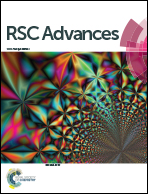Comparative DFT and DFT-D studies on structural, electronic, vibrational and absorption properties of crystalline ammonium perchlorate
Abstract
We investigated the structural, electronic, vibrational and absorption properties of crystalline ammonium perchlorate (AP) at the pressure of 0–250 GPa by pure density functional theory and vdW-corrected DFT methods. It is found that a vdW correction is very necessary when studying the structure and properties of AP under different ranges of pressure, and the effects of vdW force are more obvious at a lower pressure than at a higher pressure. A structural transformation happens at 60 GPa and makes the positions of the anions and cations in the crystal rearrange. AP is chemically stable at all the investigated pressures and this unbelievable high stability is mainly due to its strong intermolecular hydrogen bonding. AP becomes more insensitive with the increment of pressure from 0 to 50 GPa, while the case is just the opposite when the pressure is increased from 50 to 250 GPa. The effect of the high pressure on the NH4 stretching mode is more pronounced than that on the ClO4 stretching mode, showing that the N–H bonds may be more easily compressed than the Cl–O bonds under compression; thus, N–H bonds are more possible to break under high pressure.


 Please wait while we load your content...
Please wait while we load your content...